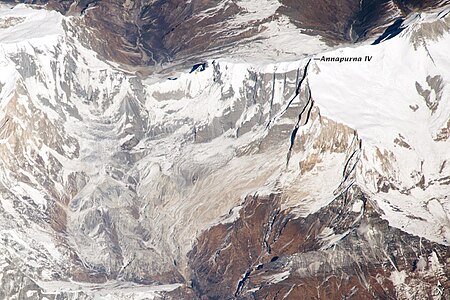Annapurna IV (Nepali: अन्नपूर्ण ४) is a mountain of the Annapurna mountain range in the Himalayas which is located in Nepal. Along with the taller Annapurna II, it is isolated from the other peaks in the range via a major col. It is the 4th highest peak of the range. It was first climbed in 1955 by a German expedition led by Heinz Steinmetz via the North Face and Northwest Ridge. The summit party comprised Steinmetz, Harald Biller, and Jürgen Wellenkamp.
Features
[edit]Despite its low prominence, Annapurna IV is an important peak relative to its immediate neighbors. The standard route of ascent for Annapurna II uses the North face of this peak to ascend to the ridge that connects the two summits, thus circumventing many of the hazards faced on that mountain. To the West, Annapurna IV drops away steeply into a major col shared with the East ridge of Annapurna III (and thus the rest of the Annapurna massif).
The Seti River valley, immediately due south of this col, provides access to the famous Southeast ridge of Annapurna III. Although subject to decades of attempts, the ridge was only successfully climbed for the first time in 2021. As of 2024, Annapurna IV's own Southwest pillar, also reachable from the valley, has repelled all climbing attempts.
Rockfalls
[edit]Rockfalls from Annapurna IV are thought to have blocked the Seti River, creating a temporary dam.[2]
-
Annapurna IV
-
The rockfall that temporarily blocked the river[2]
See also
[edit]References
[edit]- ^ "Peak Bagger:Himalaya, Central Nepal Himalaya, Khumbu, Ghurka Himal, Annapurna Himal, Xishapangma Area, Sikkim-Eastern Nepal Himalaya, Western Nepal Himalaya, Assam Himalaya, Punjab Himalaya, Bhutan Himalaya, Garwhal Himalaya, Ganesh Himal". Retrieved 22 October 2024.
- ^ a b "Making Sense of Nepal's Seti River Disaster : Image of the Day". earthobservatory.nasa.gov. 22 December 2013. Retrieved 6 March 2020.
External links
[edit]




![The rockfall that temporarily blocked the river[2]](http://upload.wikimedia.org/wikipedia/commons/thumb/3/3d/ISS038-E-020918ann.jpg/400px-ISS038-E-020918ann.jpg)